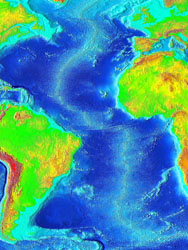The North American plate and the sea floor

Q. Does the speed at which the North American plate diverges outstrip or match the speed at which new sea-floor is laid down? My understanding is that the continents ride on the lithosphere, not on oceanic crust and therefore because it's a passive margin wouldn't oceanic crust be piling up exponentially, either in the mid-Atlantic or near to the continental rise?
From Rory McKeown (June 2013)
Reply by Nick Rogers
The answer to this is no, the speed that N. America is moving away from the mid-Atlantic ridge matches, indeed controls, the rate at which new ocean lithosphere is generated at the ridge. This question reflects the view of continental drift that many Earth scientists adopted before the advent of plate tectonics – how could the continents move ‘through’ the oceans without the accumulation of a vast amount of deformation within the ocean basins.
In the case of N. America, you need to think of the N. American plate, which comprises both continental and oceanic lithosphere, and stretches from the Mid-Atlantic ridge in the East right across the western Atlantic ocean, and the whole of the N. American continent to the complex set of plate boundaries along the western seaboard of N. America (including the San Andreas fault). This whole section of oceanic and continental lithosphere is moving as a single unit – the N. American Plate. Any deformation is accommodated at the plate margins, hence the mountainous and volcanic geology of western N America.